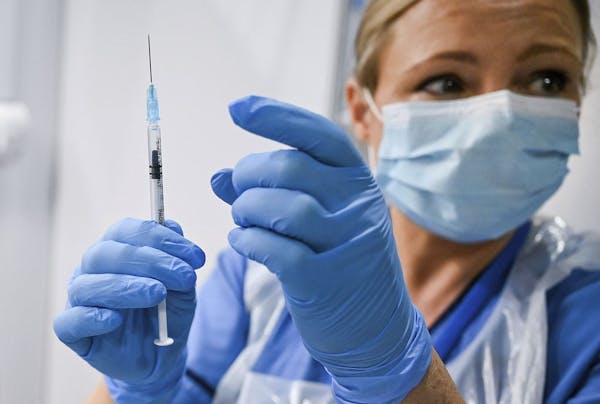Coronavirus infections remain rare among Minnesotans fully vaccinated against COVID-19, with 2,550 cases reported Tuesday by the state Department of Health.
These breakthrough infections represent 0.1% of the nearly 2.3 million people who have been fully vaccinated in Minnesota, indicating to state health officials that the vaccine is protective. Fully vaccinated means that 14 days have elapsed since people received their final shot in the one- or two-dose series.
"The data … strengthen the argument that vaccine is a significantly valuable tool in this fight against COVID," state infectious disease director Kris Ehresmann said.
Minnesota's breakthrough cases include 239 people who were hospitalized — though some were admitted for other reasons and only learned of their infections through routine hospital testing. Twenty-six of these hospitalized patients died of COVID-19 illness at an average age of 74.
Overall, Minnesota's death toll in the pandemic reached 7,381 Tuesday with the reporting of an additional 11 fatalities from COVID-19 illness.
The Centers for Disease Control and Prevention on Tuesday published a review of more than 10,000 breakthrough cases in Minnesota and a few other states and found that 27% were asymptomatic and identified through routine screening.
Newer and more infectious variants of the SARS-CoV-2 coronavirus were responsible for 64% of breakthrough infections in the federal report, but that was based on a review of only 555 cases that had genomic sequencing data to identify the strains involved.
"The number of COVID-19 cases, hospitalizations, and deaths that will be prevented among vaccinated persons will far exceed the number of vaccine breakthrough cases," the CDC report stated.
Public health officials believe vaccination progress in Minnesota shortcut this spring's pandemic wave — despite a more infectious B.1.1.7 variant causing three-fourths of the state's new cases.
The 256 infections reported Tuesday was the lowest single-day figure in Minnesota since last June, and the positivity rate of COVID diagnostic testing, a key measure of viral transmission, dropped to 4.2%. It peaked at 7.5% on April 11.
Hospitalizations for COVID-19 in Minnesota declined from a peak of 699 on April 14 to 368 on Monday.
In Minnesota, more than 2.8 million people have received at least a first dose of COVID-19 vaccine — amounting to nearly 61% of the people 12 and older who are eligible. The total includes more than 60,000 recipients 12 to 15 who became eligible earlier this month when the age eligibility for the Pfizer COVID vaccine was reduced from 16 to 12.
Nearly 64% of Minnesotans 16 and older have received vaccine, bringing the state closer to its incremental goal of a 70% vaccination rate among residents by July 1. The state needs to provide shots to about 284,000 more people 16 and older to reach the goal.
Minnesota also is closing in on President Joe Biden's related goal of providing vaccine to 70% of adults 18 and older by July 4. Nine states already have surpassed that goal while Minnesota has reached 66% and ranks 14th among states for its adult vaccination rate.
The 11 COVID-19 deaths reported Tuesday included nine people who lived in private residences and two who lived in long-term care facilities that were prioritized for COVID vaccine earlier this winter. Residents of long-term care made up 64% of Minnesota's COVID deaths in 2020, but only 48% of the deaths in 2021 so far and 26% of the deaths since April 1.
Minnesota in the pandemic has reported a total of 599,477 infections identified through diagnostic testing.
Despite its vaccine progress and declining infection numbers, Minnesota still ranked fourth worst among states in the week ending May 13 for its rate of new infections, according to the weekly federal COVID-19 State Profile Report released on Tuesday.
The state had one of the highest rates of new infections caused by B.1.1.7 and other more infectious variants of concern. That could explain why the latest wave was more severe in Minnesota, but it also could be because the state has been more aggressive than others in conducting genomic sequencing to find variant-driven infections.
Minnesota will continue to conduct aggressive surveillance as well for all types of breakthrough infections, Ehresmann said, despite the recent switch by the CDC to track only such infections that result in hospitalizations or severe outcomes.
Ehresmann said continued identification of breakthrough infections will ensure that the vaccine is protective and also monitor for any variants or changes in viral activity that could undermine it.
"This is allowing us to have really good information," she said, "about what's happening on the ground in Minnesota."

Teen suspect in Nudieland mass shooting arrested on murder, assault charges
'Human error' behind Robbinsdale shelter-in-place alert that was mistakenly sent countywide

Going to Wolves or Twins tonight? How to get there (and maybe avoid traffic).
Focusing on bringing football film into frame

